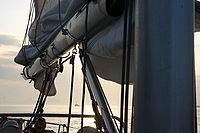
Boom vang
Encyclopedia

Sailboat
A sailboat or sailing boat is a boat propelled partly or entirely by sails. The term covers a variety of boats, larger than small vessels such as sailboards and smaller than sailing ships, but distinctions in the size are not strictly defined and what constitutes a sailing ship, sailboat, or a...
used to exert downward force on the boom
Boom (sailing)
In sailing, a boom is a spar , along the foot of a fore and aft rigged sail, that greatly improves control of the angle and shape of the sail. The primary action of the boom is to keep the foot of the sail flatter when the sail angle is away from the centerline of the boat. The boom also serves...
and thus control the shape of the sail. An older term is "martingale".
The vang typically runs from the base of the mast
Mast (sailing)
The mast of a sailing vessel is a tall, vertical, or near vertical, spar, or arrangement of spars, which supports the sails. Large ships have several masts, with the size and configuration depending on the style of ship...
to a point about a third of the way out the boom
Boom (sailing)
In sailing, a boom is a spar , along the foot of a fore and aft rigged sail, that greatly improves control of the angle and shape of the sail. The primary action of the boom is to keep the foot of the sail flatter when the sail angle is away from the centerline of the boat. The boom also serves...
. Due to the great force necessary to change the height of the boom while a boat is under sail, a line based boom vang usually includes some sort of a pulley
Pulley
A pulley, also called a sheave or a drum, is a mechanism composed of a wheel on an axle or shaft that may have a groove between two flanges around its circumference. A rope, cable, belt, or chain usually runs over the wheel and inside the groove, if present...
system. Hydraulic piston vangs are used on larger sailboats and controlled by manual or electric hydraulic pumps.
The term kicking strap is normally shortened to "kicker" whilst sailing. e.g. "Hard on the kicker when we get to the leeward mark"
On some sailing boats, such as the 49er
49er (dinghy)
The 49er is a double handed twin trapeze skiff type sailing dinghy. The two crew work on different roles with the helm making many tactical decisions, as well as steering, and the crew doing most of the sail control. The design, by Julian Bethwaite, the son of Frank Bethwaite , is revolutionary...
, rather than a set of lines pulling the boom downwards, a rigid member is used to push the boom down. As this is the reverse of a vang, it is known as a "gnav".
By controlling leech tension, the boom vang is one of the three methods of controlling sail twist
Sail twist
Sail twist is a phenomenon in sailing where the head of the sail is at a different angle of incidence from the foot of the sail in order to change the lift distribution with height. Twist is measured by comparing the angle of a straight line between the leading edge and trailing edge with that of...
.
On small sailboats and some cruising sailboats a vang may be omitted. If a vang is not installed, then the sheet
Sheet (sailing)
In sailing, a sheet is a line used to control the movable corner of a sail.- Fore-and-aft rigs:Fore-and-aft rigs comprise the vast majority of sailing vessels in use today, including effectively all dinghies and yachts. The sheet on a fore-and-aft sail controls the angle of the sail to the wind,...
has to try to control both horizontal and vertical angles of the boom. When the boom is near the centerline, the sheet is nearly vertical, and can exert downward force on the boom. As the sheet is loosened to increase the horizontal angle of the boom and sail, the sheet becomes horizontal and exerts less downward force. A vang works with the sheet to apply the downward force on the boom at all horizontal angles, allowing the sheet to be used to control the horizontal angle of the boom effectively.
While under sail, the opposite force to the vang is supplied by the sail itself. When the sail is furled, a topping lift
Topping lift
The topping lift is a line which is part of the rigging on a sailboat; it applies upward force on a spar or boom. The most common topping lift on a modern sailboat is attached to the boom....
supplies the upward force on the boom. Some line vang systems incorporate a piston to provide the topping lift force and to damp oscillations. Hydraulic vangs can inherently act in the topping lift role.

